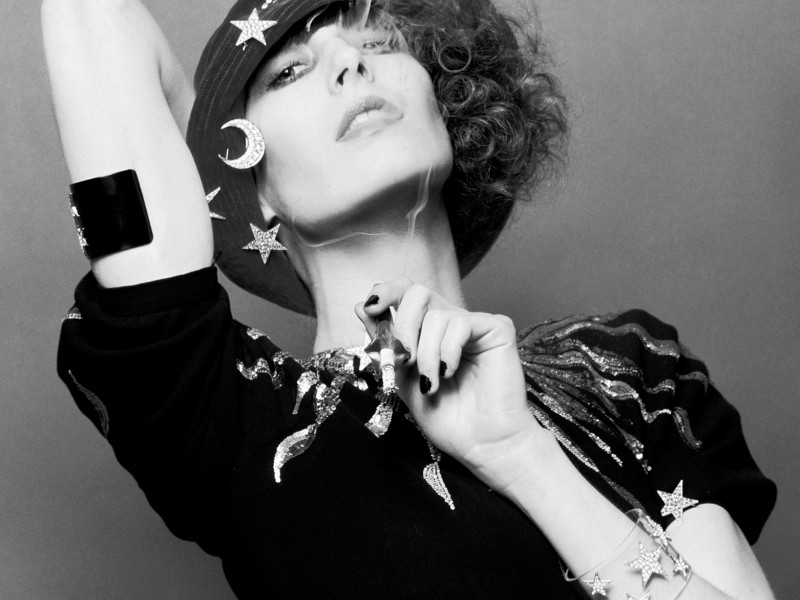I first laid eyes on Tom of Finland in 1980 at Stuffed Olives, a basement gay bar of some disrepute in downtown Manchester. Not the man himself, unfortunately, he was just a distant, mythical name. I’m referring to his art, and more specifically to the defining characteristics of that art: the men.
Tom’s men are a wake up call for the uninitiated. They are men to the power of ten. Not your average Joe, or boy next door, Tom’s man is a prime example of hyper masculinity pumped up to homoerotic largesse. The geometric jawlines, tumescent erections and otherworldly physiques are both lifelike and unreal. They ignite arousal in the most primal way, but the subject matter remains tantalisingly out of touch. They are Gods.
He is the artist behind some of the most iconic gay imagery ever produced, creating thousands of drawings, from the 1940s onwards, that robbed straight culture of its most masculine archetypes and recast them as leather-clad lotharios. These are gay men, but not gay men as imagined by the unsympathetic. The way they look, their manner, the unapologetic virility, kick-started a homosexual revolution that cannot be reversed.
Tom showed us that being attracted to the same sex was something to be encouraged and celebrated, gay longing, as personified by weakness and the imaginary limp wrist, was a thing consigned to the past. This unassuming Finnish man, acting on pure instinct and a healthy regard for his subject, created a club for heroes with its very own uniform. Although fictional, his furtive, well-hung studs, brimming with sexual energy, were far more than mere sketches. They were the blueprint for a parallel universe, a place where anything—and anyone—is possible. Tom was advocating a kind of gay liberation decades before that came to fruition. His bold, pleasure seeking characters defied convention and simply dared to be. Those that dismissed his macho-chromatic work as cartoon porn are woefully short sighted. Tom’s men were the future.
There are generations of people for whom Tom represents an indelible part of their upbringing. Artists, photographers, performers—the unapologetically horny—have all fallen under his spell in some shape or form. Whether by default or design, Tom’s men, or what they represent, have united taste and sexuality in the most fluid way imaginable.
Paul Rutherford, one time member of pop provocateurs Frankie Goes To Hollywood, credits the imagery of Tom of Finland as a formative influence on the band’s visual identity and pro-gay stance. “I had this older friend, Yvonne Gilbert, who exposed Tom to us, and the imagery is something we really stole from. Of course, I wanted men like that, but for me it was more thrilling to see the drawings. It was art more than it was porn, stuck in this mad little place.
“I fancied the cartoons before I fancied the men,” he laughs. “Tom’s men were always good looking. They didn’t smell of sweat and poppers, they’re a fantasy you want to come to life. In fact, I was rather disappointed when I got to a gay club! Back then we created our own world. We weren’t scared of wearing leather in the middle of the day, or jockstraps to clubs. I think it was Tom of Finland who urged everyone on to do that.”
Roy Brown is a Tom of Finland drawing come to life. As a singer, model and muse to photographers such as Juergen Teller and Pierre et Gilles, his sculpted look and generously proportioned nipples are the stuff of subculture legend. If he had been born in another era, things might have been different, but the silhouette brought about by Tom’s lines determined his self image. “Tom was the awakening of me. I’d always been athletic, but as soon as I saw those images I started to work out really seriously. It gave me something to aspire to. I’ve always had large nipples. I used to hide them when I was younger because I was very uncomfortable, but Tom’s images said something to me and gave me a reason to celebrate them. Tom was almost like a fashion designer if you think about it. All those uniforms moulded onto the human form. Everything looked so lush and sensual—the jodhpurs the boots, the meticulous attention to detail. It was through those pictures that I got into the whole leather and rubber scene.”
Style aside, how did Brown feel about Tom’s depiction of black men? “I’m not sure about the images of black guys in chains,” he frowns. “In whatever context, it does dredge up negative images, but I don’t think Tom was coming from that. And were the guys wincing in pain or pleasure? There’s a fine line. The bad guys get their comeuppance and the good guys always get their rocks off. It’s a sexual fable almost. At the end of the day Tom of Finland is a celebration of sex and having a good time.”
Touko Laaksonen, better known by his pseudonym Tom of Finland, was a prodigious artist from an early age. His subject matter was his surroundings, a rural countryside populated by masculine farm hands and blue collar workers, the type of man he quickly came to admire. Moving to Helsinki as a young art student brought him into contact with metropolitan gay life, but the camp revue bars and the effeminate men who patronised them were not to his taste.
By the time he was 20 he found his sexual playground in the clandestine cruising grounds of Europe. As a keen traveller, numerous liaisons with men propagated a taste for the adventurous and these early encounters became the subject of his drawings. The aim was to create an ideal type. “The guy was an embodiment of my own dreams,” he said in 1987, “taking all the properties that I myself do not have and putting them into a comic figure”.
As a soldier, Tom fought alongside the German army in WWII, against the Russians, and it is at this juncture that his most obvious fetish was born. The form fitting uniform of Nazi officers, sailors wearing bell-bottoms—the look and authority of servicemen was a sexual wake up call he could not ignore. Fired up with a new optimism he was inspired to draw real people in situations where they were having fun. Why shouldn’t these men be happy? Tom wanted to correct the injustices of real life through tender fantasy. He wanted to show that masculine looking guys have deep feelings too. “My drawings are primarily aimed at individuals who may have experienced misunderstanding and oppression and feel that their lives have gone wrong. I want to give them encouragement. I never want to classify people.”
For many years the Finnish artist’s graphic pencil drawings were the preserve of a twilight demimonde. By the time they crossed the pond and found themselves on the pages of Physique Pictorial they were still a niche concern. This American publication, featuring black and white photographs of nubile street kids, hustlers and out of work actors purported to be about health and fitness, but the customer knew otherwise. He signed his work ‘Tom’, and in the anonymous spirit of the era they christened him ‘Tom of Finland’. In those early years few people were privy to the work—a small demographic of fledgling gays and closeted, often married men. By the late 1970s his notoriety gained, as did his audience. Suddenly, what were once deemed ‘porno drawings’ found their way into major museums and the private collections of art connoisseurs. Gay sex had found its natural identity.
Wikipedia describes the art as ‘mostly featuring men with exaggerated primary and secondary sex traits with tight or partially removed clothing’. While factually correct, the formality of the description hardly does him justice. There is emotion at work here, the way these figures look at each other, their expressions—in Tom’s universe there was always bonding and camaraderie. Admittedly, much of the acrobatic sex—often violent and demeaning—is questionable, especially when taken out of context, but it’s important to remember the motivation was to arouse and stimulate. So confident was Tom’s vision, these bullish caricatures also made you smile.
As a fan of the perverse (William S. Burroughs dubbed him ‘the Pope of trash’) filmmaker John Waters has long admired the humour inherent in Tom’s work. “Tom of Finland is, of course a great artist,” he has said, “there can be no debate about that anymore. His drawings are beautiful, confident, sexy, totally original and butch-elegant … He invented a look and you better respect it. He may have been a ‘daddy’ type later in life, but I’m not so sure he would have approved of the ‘bear’ movement. After all, isn’t a ‘bear’ just a Tom of Finland man who let his body go?”
To artists, designers and the creatively open minded like Waters, Tom’s drawings exert a profound and enduring influence. The great American photographer Robert Mapplethorpe, an equally ardent fan of the male form, is a notable example. “The image of gay men today in leather and uniform is directly related to Tom of Finland,” he said in 1983. “The gay macho look that Tom was responsible for creating and disseminating went on to become the major icon of sexuality in our culture today.” Mapplethorpe is not alone in his admiration. The director Rainer Werner Fassbinder took obvious cues from Tom of Finland in his 1982 film adaptation of Jean Genet’s novel Querelle. As the eponymous lead, actor Brad Davis was Tom’s sailor come to life. The world of fashion has also looked to Tom for his svelte rendering of clothes for inspiration. The work of photographer Bruce Weber almost always idealises the homely good looks seen in Tom’s men, while designer Thierry Mugler camped up the aesthetic to proportions the artist would surely have approved of.
Mark Wardel aka TradeMark is a British artist and illustrator also significantly influenced by the Finnish master. “I became aware of Tom’s work through my friend Antony Price, the fashion designer,” he remembers. “What Antony was doing at the time, back in the late 1970s, was basing all the cuts of his men’s clothes on Tom of Finland’s body shapes. He had these trousers called ‘arse pants’, and the way they were seamed made the crotch bulge out and lifted the buttocks to give that definitive Tom of Finland shape.”
Wardel’s commercial work blends the style of Interview cover artist Richard Bernstein with the silk screens of Warhol and Tom of Finland’s smooth perfection of manhood. “When I started doing artwork for clubs like Trade and Heaven in London, Tom of Finland was one of the people I was immediately drawn to. His style of masculinity had a great appeal for the new generation of muscle queens and clones who frequented those places. Tom invented that look. It was all completely influenced by him. It’s become a logo for masculinity. A living logo.”
“He was a master of graduated tones—a technique where you build up a tone through layers, then smudge to give an almost airbrushed effect. This laborious process could take him up to two weeks to complete one drawing. He was also an absolute genius at depicting the male body—very clever at exaggerating elements of the male physique to create arousal within them. He knew where every muscle went and how shadow would fall on skin. His drawings are faultless.”
Related Features
-
214
-
-
-

